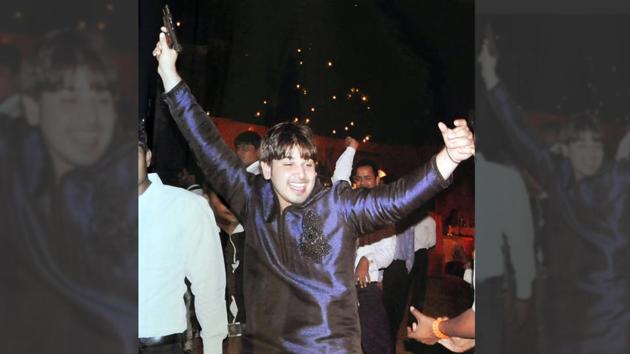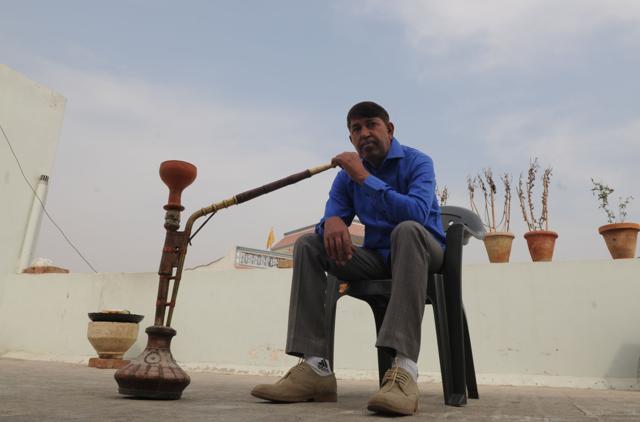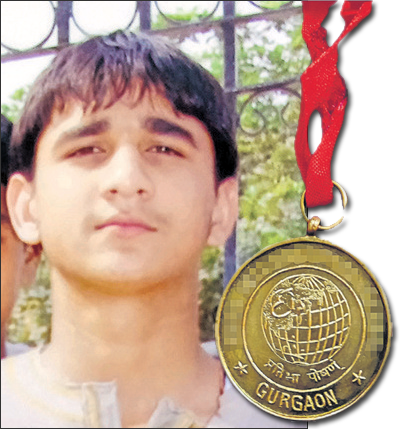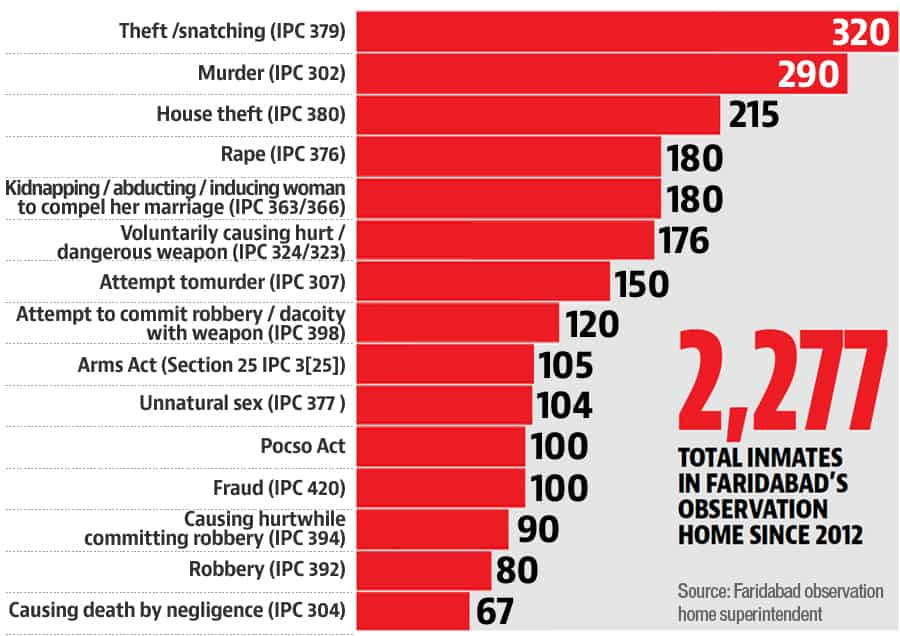How a high-profile school killer became a leading don in Haryana’s underworld
The 28 February acquittal of bus conductor in last year’s murder of a schoolboy in Gurgaon has turned focus on to the other accused, a juvenile. We go back to 2007 when another teenager shot his classmate at a school and find that he is now a leading Haryana don.
On 11 November 2007, 14-year-old Akash Yadav, the son of a real-estate dealer in Gurgaon, took his father’s imported 0.32 Harrison pistol to his private school and shot a classmate to settle a score. He was sentenced to three years in a juvenile observation home. Now 24, and the leader of a criminal gang, Akash Yadav has spent three years across two jails in Haryana for his last alleged murder.

In a repeat of 2007’s school scandal, on 8 November 2017, a CBI investigation charged a 16-year old boy at another international school in Gurgaon for slitting the throat of an eight-year-old fellow student. In the three-and-a-half months since the suspect was sent to Faridabad’s juvenile observation home, several questions have been raised about him — from his motivation for the alleged murder, to the state of his mental well-being, to the argument for trying him as an adult. The only question no one is asking is this: what happens to the 16-year-old if he is convicted of the murder? No one knows the answer to that. We do know, however, what happened to the 14-year-old who had committed the same “mistake” 10 years ago.
The missing gun
At 9.45 am on 11 November 2007, property dealer Azad Singh Yadav came back home from his morning walk, opened the top drawer of the television table, and found his pistol missing. He had bought the imported pistol from a dealer only the previous week, loaded it with five cartridges, put in a clear plastic bag and slipped it into the drawer. Buying and selling of land was by 2007 the leading business in Gurgaon and one that increasingly involved the use of firearms. It had only been three years since Yadav sold his own family land in the village of Bhamrauli, moved his family to Gurgaon, put his sons ,14 and 11, in an“international” school, and got down to business. Akash was the elder of the two siblings.

The first thing Azad Singh did after closing the drawer was to call the school and ask to speak to his sons. Both of them denied having anything to do with the missing pistol. Worried about where it may have landed, Yadav drove to Mewat to consult an astrologer who specialised in predicting the locations of stolen objects. He was told the pistol would soon return to its place. He was driving back to Gurgaon when he got a call from the school informing him that his older son, Akash, had shot a classmate.
At 1 pm, just after the classes at his school ended for the day, Akash went to the boys’ bathroom, took out a pistol from under a toilet, proceeded to the stairwell with a friend, Vikas Yadav, and waited for his “enemy”, Abhishek Tyagi, to come down the stairs. When he came face to face with Abhishek, Akash pulled out the pistol from his pocket and took aim — two bullets through the forehead and two into the chest. He passed on the pistol to Vikas as Abhishek was collapsing to the floor. His friend fired into the bleeding body. “At 2 pm, I got a call from my son’s school saying he had been hurt,” said Ravinder Tyagi, a property dealer from sector 14 who had recently admitted his son to this school that proudly advertised the “safety of every child”. “When we reached Pushpanjali hospital, Abhishek was lying on a stretcher. I took his hand in mine; it was cold and limp.”
Tyagi continues to think his son was killed because he was better than Akash at sports. “He had beaten Akash at a football match just a few days before the incident. They had clashed with each other after. The school had to mediate and make them shake hands.”

Akash’s family thinks it was all about a girl.
“My son told me Abhishek used to bully his girlfriend in school,” said Kamlesh Yadav, Akash’s mother. “Things went way out of hand when Abhishek caught hold of her hand,” said his younger brother, Sumit, who was then in Class 6 in the same school. “Bhai was furious, he was planning to teach him a lesson and he told me that ‘I will not leave Abhishek’.”
The first person in the family with whom Akash spoke was his father. “My father was shocked as Akash told him on the phone, ‘Papa, I am sorry, I have made a mistake’,” said Sumit. “Papa did not n scold Akash, but assured him of his support.” Television cameras had surrounded their house even before Akash reached the police station. “Every channel was showing the incident,” Sumit said.
Few people had heard of a school killing in India before, even though there had been a couple of incidents here and there. The shooting represented the dangers of transition from one way of living to another. All three families (Akash’s, Vikas’ and Abhishek’s) had moved from traditional Haryanvi villages to the “cyber” city of Gurgaon, the fathers spent their time dealing in land, and the sons felt free to follow their instincts. Newspaper articles reporting the incident referred to the effects of the “new, property-driven wealth” and “modernity” on the “minds of these children”. One of the witnesses said he had seen Azad Yadav teach his son how to fire a gun. The family continues to refute the claim. “What father would teach his son to operate a revolver?” asked Kamlesh.
A large crowd had gathered outside the juvenile court in Gurgaon on the day Akash Yadav and Vikas Yadav were presented before the magistrate. Every detail was captured: what the boys ate that morning in the observation home (“parathas with chai”), what they wore to the court (“jeans, sports shoes, hoodies”), how they appeared inside (“Akash kept looking down, Vikas looked around”) and what they said (“Akash: I acted out of anger, shouldn’t have done what I did.”).
To control the damage to Gurgaon’s image, Haryana’s education minister stressed on moral education in its schools. The international school responded to the call by inviting a parade of spiritual leaders the following week. The initiative ended with a three-day workshop by the Art of Living. On December 11 2007, the court sent Akash back to Faridabad’s juvenile observation home for three years. His father was sentenced to a year in jail for keeping an unlicenced gun at home.
Gangs of Gurgaon
There are currently 380 inmates in Haryana’s sole observation home for juvenile offenders in Faridabad. They come in facing all kinds of charges. Since 2012, 290 teenagers have been sent there for murder, 150 for attempt to murder, 180 for rape, 176 for “voluntarily causing hurt”, and 120 for “attempt to commit robbery”. Faridabad tops the list of cities from where they have arrived at this place since 2012, with 860 offenders, and Gurgaon comes second with 710. Teenagers are central to the functioning of Haryana’s underworld, says principal magistrate at Gurgaon’s Juvenile Justice Board, Davender Singh, who hears up to 20 cases of juvenile offences in a month. “Professional gangs use them because, if caught, they get out easily and can be used in rotation. Most juvenile criminals who appear before me are repeat offenders — for theft, robbery, dacoity. Most of them are from middleclass families. The reasons they take to crime are many, from poor parental monitoring to a desire for an expensive lifestyle.”
“I noticed that the children are mostly lonely and isolated, their family members do not have time for them,” said Dr Jogender Singh Kairo, a senior clinical psychologist appointed by the Haryana government to conduct psychological assessment tests of juvenile offenders. “The parents play a very important role in these cases as the traits, temper, and conduct of a child is seen in a growing age and they should know the temperament of the child”. Having conducted 35 such tests since January 2016, Kairo says most teenagers accused of “heinous” crimes weren’t aware of the consequences.
“The environment plays a role: bad company, drinking, drugs. Most kids I interview with tell me ‘I committed a mistake’,” said Nisha Saini, a child protection officer with the Haryana government.
“It’s easy to put all the blame on outside factors, but where is the system’s responsibility?” asks Eenakshi Ganguly, noted child rights activist, “Why do teenagers repeat crimes? Children are dehumanised inside these institutions. We are creating devils out of these people.”
Increasingly, said Davender Singh. Gurgaon’s gangs also hire migrant teenagers from Assam, Uttar Pradesh, West Bengal and Bangladesh.
By the Gurgaon police’s estimates, at least 10 major criminal gangs operate in and around the region. The history of Gurgaon’s underworld is as old as Gurgaon itself. In 1979, the existing district of Gurgaon, which lay 32 km southwest of Delhi, was divided into two industrial zones of which one continued to be called Gurgaon. By the early ’90s, this land had turned to gold as it became the preferred base for companies looking for an alternative to New Delhi’s crowded and poor-quality commercial area.
In 1995, a former advocate, Bunty Yadav, took on the alias Fauji and launched a criminal gang to charge protection money from the new businesses. In 1996, Rajesh Thakran, alias Rajje, followed up with a gang that specialised in extortion, but also settled real-estate disputes for a cut, and occasionally took up hit jobs. Later that year, Fauji eliminated Rajje to reclaim his turf, but it was already too late. In 1998, a former constable with the Delhi Police, Dilip Kumar, jumped into the business with a gang called D-Company and added another item to the existing portfolio: charging ransom from rich residents of newly built gated communities. The spread of Gurgaon’s underworld has since been unstoppable. So has its circle of influence.
Land remains central to their operation, but the gangs compete with each other to control every new avenue for easy money — from human trafficking to illegal gambling. As the stakes get higher, rivalries are settled on streets and in markets.
In 1996, the police recorded two gang wars. As of 2015, 50 notorious gangsters involved in murder, extortion and kidnapping were lodged in the Bhondsi Jail.
The relationship between the police and the mafia in Gurgaon isn’t always antagonistic, according to observers. In 2015, the Gurgaon police raided the residence of runaway gangster Sandeep Gadoli, who had just eliminated a rival, and found two diaries containing valuable details. The first listed the amount of monthly rent his gang collected from businesses — sweet shops, jewellers, bakeries, garment showrooms — and revealed the monthly earnings to be no less than Rs 3 crore. The second diary listed the bribes Gadoli was allegedly paying police officers — constables, head constables, sub-inspectors, additional commissioners and even director generals — to let him carry on with his business. The amount ranged from Rs 3 lakh to Rs 18 lakh. “There are no doubts about the evidence and the list of industrialists and businessmen who are paying monthly extortion fees to the syndicate,” said then deputy commissioner of police, Ved Prakash Godara. He was less forthcoming about the second diary. “We will thoroughly scrutinise the contents,” he had said.
In February 2016, the Gurgaon police chased down Sandeep Gadoli in Mumbai and killed him in an encounter. His death left an opening at the top of Gurgaon’s underworld. Several gangsters rose to fill the gap; one among them was Akash Yadav. If you believe him though, he didn’t want to end up a gangster when he left the juvenile observation home in Faridabad. “I wanted to go back to school,” he said from behind the bars in Hisar Jail in January.
Schoolboy to gangster
From the outside, Faridabad’s observation home looks like a small school — a brick building surrounded by a vegetable garden — but a different world awaits teenagers inside, where 10 of them live in one cell, sleep on dirty mattresses, and line up outside smelly toilets. Akash and Vikas were the only schoolboys in a cell packed with repeat offenders. Neither he nor his family talks about his experience inside, except to say that it was no place for a privileged kid. “You know what happens in these places: bullying, sexual abuse, violence,” said Sumit. “It’s a different world from outside,” said Akash.
“This is a complete failure of the system and the society,” said Ganguly. “The law says there has to be an individual care plan for each juvenile based on their specific needs. What kind of psycho-social support are the authorities providing? Who is addressing their sexuality issues? Who is providing them with opportunities for education, skilling, deaddiction? In my work for juvenile convicts, we have found that if you work with them on these lines, they don’t turn into repeat offenders.”
Most kids survive by finding someone a few leagues above them in a juvenile jail’s been-there-done-that hierarchy. Akash found an 18-year-old hitman from a village gang in Rohtak. “One day, bhai arranged a beedi for shooter Manjeet from village Sunariya. They became best friends. It was a turning point in his life. Slowly, bhai won hearts inside the observation home and began to be seen as a leader,” Sumit said.
The status comes attached with opportunities. “Different gangs started motivating bhai to join their group through their members inside the home.”
However, Akash was keen to return to “normal life”. In 2008, he came out of the observation home on bail. He was 15. His parents had moved back to their village, Bhamrauli, on Pataudi road in Gurgaon. In 2010, he took his Class 10 board exam from an open school in Faridabad. “Then, we admitted him to a regular school in Faridabad for Classes 11 and 12, but a friend of Abhishek’s joined the school a few months after, told everyone about Akash’s past, and the principal asked us to take our son out,” said Kamlesh, his mother. The family made a few more attempts at returning him to school. “They always found out who I was and struck my name off the rolls,” said Akash.

In 2012, the 19-year-old passed his Class 12 board exam from another open school, this time in Delhi. Keen on studying law, Akash went as far as Alwar in Rajasthan to enroll in a law college, but as Sumit puts it, “destiny had other plans”. His mother said Akash returned from Alwar unable to concentrate on studies. “Gangs used to contact him and threaten him to join them or else face consequences. Whenever he was home, he did not come out of his room, kept slipping into depression, and used to cry.” Since he came out of the observation home, Sumit said Akash “never slept peacefully”.
“Akash decided that enough is enough,” said Kamlesh. At 19 years of age, he believed he had two options: to join a criminal gang or to start his own. “Bhai decided to form his own gang,” said Sumit. Following the established traditions of the Gurgaon underworld, Akash Yadav’s gang began with extortion. “An establishment is making ?1 lakh a day, we say to them, ‘give us ?50,000 a month or kaam band, khatam’ (business over, finished). Most of the time, a warning is enough,” said Sumit, who joined Akash in the “crime world” frustrated with being bullied as “the brother of a murderer”. Since 2016, Sumit has been charged with a wide range of crimes: section 147 (rioting), 149 (unlawful assembly), 323 (assault), 325(voluntarily causing grievous hurt), 506 (threatening life), 354 B(assault or use of criminal force to woman with intent to disrobe) and under the Arms Act, according to Jai Kishan Chillar, superintendent at the Bhondsi jail.
The pros outweigh the cons for him, though. “We control the areas south of Gurgaon — Palam Vihar, Udyog Vihar, Kapashera. Everything is free for me. Today we have more than 100 members in our gang and it will soon be the most powerful gang in Haryana. Akash wants to form his empire in Haryana,” said Sumit, who wears a beard and a hoodie, moves around in SUVs with tinted glasses, and meets people in empty basements. His mother is thankful for the swanky three-storey house her son has built for the family in Bhamrauli village, fitted with imported tiles inside and CCTV cameras outside.
The family claims Akash runs a gang with a conscience. “No robbery, no dacoity, only extortion,” said Sumit. “He has never been involved in dirty crimes like rape or molestation,” said Kamlesh. Akash himself said he ran a gang only to “settle personal rivalries”. According to police and jail records, however, from 2007 to 2015, Akash Yadav and his associates had been charged with about a dozen criminal cases: attempt to murder, robbery, snatching, extortion and assault. Sumit says Akash doesn’t involve himself in anything less pressing than a murder. “If he has to kill someone, he does it himself. He never threatens but believes in eliminating.”
In early 2015, Akash decided to eliminate a man called Manish Kumar. Kumar had come to Gurgaon from Bihar as a teenager looking for work and had ended up working for criminal gangs.
By the time Akash met him in Kapashera, Manish had been to jail several times for snatching gold chains and mobile phones, carjacking and other petty crimes. They became friends and remained close for many years. Manish spent all his time at Akash’s house and helped run his gang’s operations. At some point, though, the Yadavs say, Manish began to feel jealous of Akash’s growing influence in the underworld. He set a trap to get Akash out of his way, according to Sumit. “He plotted with an enemy gang and called Akash to a wedding. Akash drove there with friends but before he got out of the car, he spotted a few members of that gang in the crowd and drove back.”
On March 24, Akash and some of his friends drove in an SUV to Palam Vihar market, where they expected to find Manish Kumar and his group. The two sides got into an argument and soon Akash whipped out a 38-bore revolver and fired five shots at Manish, who took three bullets and collapsed right away, according to Rajesh Kumar, assistant commissioner of police. Akash fled the scene and remained absconding for 14 days. On April 7, he was found near Sultanpur Lake, on the outskirts of Gurgaon, and sent to Bhondsi jail. He has since been a so-called undertrial — waiting in prison till his case goes on.

Kill or be killed
Long before her son shot dead a classmate, Kamlesh had gone to a reputed astrologer to seek a clue into his future. “The astrologer told me your son will be ‘known’ in official circles and in his words ‘woh sarkari gaadi mein ghumega’ (he will roam in government vehicles) aur ‘sarkari khaana khayega’ (eat government’s food),” said Kamlesh.
She added, “I thought he will get a government job and become powerful. I had never imagined that ‘sarkari gaadi’ will be a police van and that ‘sarkari khana’ will be prison food.”
By November 2017, when he heard about the teenager accused of killing a fellow student in the Gurgaon school, Akash had spent a month in Hisar jail. In October, Akash was transferred from Bhondsi to Hisar after he assaulted his supervisor in the prison. On January 11, 2018, when Akash came to the jail’s visitors’ enclosure to meet his mother, the gangster looked tired and solemn. His mother has been concerned about his shaved head and gaunt, bearded face; Sumit says Akash likes to keep changing his look. Indeed, the 22-year-old who was arrested in 2015 had chubby cheeks and wore his hair long and blonde.
Since he chose to “follow his destiny” in 2012, Akash has progressively been less and less a person and more and more a myth: a dazzling don with a big heart. According to his mother, Akash is “paying the price for being a good man”. Kamlesh said her son was “betrayed by those he most trusted”. He loves the good life — big cars, fancy clothes and imported guns — but is also a deeply religious man, according to her. “Never leaves the house without doing pooja. Observes fasts on Tuesdays, and over the 10 days of Navratra.” He “respects women,” she added. “He has often assaulted people who are seen disrespecting women in public.” “When he comes out of jail,” she said, “he wants to open a cow shelter and an old-age home.”
According to Sumit, Akash is a “loving” brother, a “great leader” and a caring boss. “He makes sure the members of the gang and their families don’t lack for anything.”
With his brother in jail, it falls to him to keep up the image. “I have to ensure each gang member is provided with best of clothes, shoes and monthly expenses, which comes to around Rs 8 lakh a month. At times there is a wedding in their families, so the expenses touch Rs 15 lakh.” The gang members repay the leader with blind devotion. “If any officer threatens him in jail, we send our boys to his house.”
Akash, too, speaks of himself entirely in abstractions. “I am very emotional. I get very angry.” Asked why he shot his classmate 11 years ago, Akash looked lost for a few moments before he spoke into his end of the twin- telephone connecting prisoners with their visitors across an iron grille: “He had been annoying me for days.” Would he do that again if he could go back to 2007? “No, I regret that mistake. I wanted to apologise to Abhishek’s parents. I tried to visit their house but after reaching their gate, I returned.”
In all likelihood, Akash will walk free in a few months. The police have poor evidence against him and the only two witnesses have turned hostile. At the last hearing of the case on February 12, the investigating officer reported that the bullets that killed Manish weren’t fired by Akash’s revolver, which couldn’t release any because of a technical glitch, but came from the pistol of one of his friends.
The previous week, Sumit was arrested from the Yadav’s family home and sent to the Bhondsi jail for criminal intimidation.
If Akash comes out of jail, he said the first thing he will do is avenge the recent murder of a cousin by an old enemy. “He killed my brother!” What about his old dreams of a normal life? “I can’t leave this world now. If I don’t kill them, they will kill me.”




